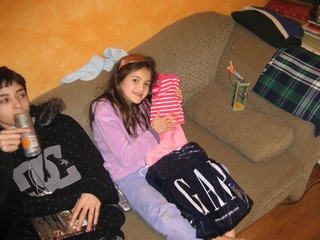
:: Our garden gate, SFLU ©2003
February 29, 2008
Trip to Bavaria 2/12-2/19
Went on a short business trip to a small town near Munich. It may be sunny looking, but first thing in the morning it was only about 10°F (-12°C) outside. This is somewhat colder than I am used to and for how I was dressed. (My companion on the trip has thought it would be about 45°F instead – last time I trust him to check the weather…)
This picture was taken near the village of Wadlhausen or Icking, which are both southwest of Munich. The Leoni Hotel where we stayed is on the Starnberger See. It’s a nice quiet lake hotel with decent WIFI. The hotel is a little ways away from anything else, however, which limited our ability to vary the evening meal.

This is the view from my hotel room, looking away from the lake toward the surrounding hills, of course. The lake was totally fogged in most of the time, so you didn’t miss much but a grey picture…

January 17, 2007
Winter in Seattle
Today is the seventh day in a row that we have had daytime temperatures no higher than 35 &&d Fahrenheit. No big deal if you are used to Minnesota or Maine, but this is Seattle. Seattle supposedly has not had a winter like this, with snow on the grounds for days on end, since before I was born in the 1950’s.
We have had many days now of night time lows down into the mid-20’s, so we are not looking forward to the heating bill this month.
Here are some pictures of the scenery around our little frozen burg…





If we get the expected snowfall this evening, it will have snowed four times in the past week. The kids haven’t been in school for over a week now as well, which means they have had seven days of class since mid-December. Still waiting to hear when they might finish this summer…
January 2, 2007
WASL requirements reduce CTE options in state
All that WASL math elbows out electives
DEBBY ABE; The News Tribune
Published: December 26th, 2006 01:00 AMThe drive to raise test scores and prepare kids for college is chipping away at enrollment in high school vocational courses, educators in several South Sound districts say.
Though it varies by school, fewer students are studying wood shop, accounting, drafting and other traditional vocational courses as districts strive to bolster basic skills.
Many schools have begun requiring students who don’t pass the Washington Assessment of Student Learning in 10th grade or middle school to take an extra math or English course for a better chance at meeting standards on their next try.
That also means they lose one or two electives, be it music, art, or a career and technical education class – courses that vocational education supporters say keep kids interested in school and expose them to career possibilities.
Statewide, enrollment in high school career and technical courses dipped 1.6 percent from 2001-02 to last school year, while ninth- through 12th-grade enrollment climbed 5.3 percent.
A recently formed coalition of labor, education and religious organizations fears the emphasis on academics is leaving behind students who struggle the most in school.
The Sound Alliance coalition recently reached an agreement with the Bethel, Clover Park, Tacoma and Seattle school districts to collaborate to make students aware of apprenticeships and careers in the trades.
“The WASL is important, but the push for standards and the WASL has the unintended consequence of narrowing the curriculum,” said Lynn Macdonald, a former high school teacher and current union representative with the Tacoma Education Association.
“If students think everything is geared toward college-bound students and don’t see any way to get to college, they essentially burn out on the education system,” she added. “Some would not leave the system if they knew about apprenticeships and career options.”
Pressure to pass the high school WASL and raise graduation rates has never been more intense.
Starting with this year’s juniors – the Class of 2008 – teens must pass reading, writing and math on the 10th-grade WASL to graduate. After last spring’s test, 45 percent accomplished that feat.
Gov. Chris Gregoire proposes delaying the math WASL requirement, the most challenging subject for test-takers, until 2011. The catch in Gregoire’s plan: teens who failed the math exam would have to keep taking a math class until they pass the WASL or graduate. One likely result: struggling students would lose more electives.
Seattle businessman and Sound Alliance partner David Allen said he supports high standards, but decries what he sees as America’s “fanaticism for academic performance” and the idea that everyone has to go to college.
He points to living-wage jobs available to students who pursue a trade in a high demand field instead of college. An example: plumbing and pipefitting apprentices are paid as they learn on the job, typically starting at $17 an hour, Allen said. After five years, a journeyman can earn more than $50 an hour.
“The reality is that society needs people in all kinds of careers,” said Allen, executive vice president of business development for McKinstry Co., an engineering, construction and building-operation firm based in Seattle.
Enrollments look lower
Career and technical education (CTE), the new name for vocational education, covers a broad variety of courses that receive extra funding and focus on employability, hands-on learning and work force relevancy.
Anecdotally, teachers say enrollment is falling in some CTE courses focusing on specific fields, such as accounting or construction, but rising in more general CTE classes such as “applied math” or the computer skills “digitools,” which some districts require students to take.
Rod Duckworth, the state superintendent’s director for career and technical education, said his department is researching why career and technical education enrollment isn’t keeping pace with the state’s overall enrollment growth. He suspects multiple factors are at play.
Career and technical educators say schools have stopped offering some courses because they can’t find instructors in those specialties, especially family and consumer science.
The Clover Park School District is among districts that have eliminated some traditional vocational courses, such as wood or auto shop, because of the high cost to keep equipment and programs abreast of industry practices.
But Duckworth says career and technical directors also tell him one recent reason for the decline is districts requiring more core academics.
In Tacoma, the state’s third-largest district, enrollment in career and technical education courses is down 5 percent this year from last year. That’s about 500 fewer students taking a CTE course.
Gil Mendoza, Tacoma’s executive director of career and technical education, cited several factors for the decline, including the district’s overall enrollment plunge and more students taking “double doses” of math or language arts. He also believes some counselors steer students considering college away from career and technical courses, even though it could help those teens explore options.
Meanwhile, the Bethel School District’s enrollment in CTE courses is rising, fueled by its increasing student population and offering of more “applied math” and other classes that can meet both academic and career and technical credit requirements.
But class size – the number of students in each class – is falling in the more specialized vocational courses such as accounting and many other electives, said Michael Christianson, Bethel career and technical education director.
“Student schedules are driven by the courses that support direct reading, writing and math instruction,” Christianson said.
At Spanaway Lake High School, Whit Baker’s “building/construction” course has 14 students. There’s room for 25.
He and Christianson would like to see more students in the class, which gives teens a taste of the booming construction field.
“The interest is there, but kids don’t have room in their (class) schedule.” Baker said.
More math, fewer electives
Junior Brittany Edenfield and sophomore Jacob Green are among the Graham Kapowsin High School students assigned to a two-period math class this semester to raise their math skills.
Brittany was placed in the class after scoring below standard on the 10th-grade WASL. Jacob failed a math class last year and didn’t pass his most recent math WASL.
Neither is pleased to be in “Math Ramp Up.”
“All I do is work on stuff that I already know and then fall asleep,” Jacob said.
Though she has French as an elective, Brittany had also wants to take child development (a career technical course) and choir. She aspires to be a doctor.
Jacob plans to join the Army. He’s taking Junior ROTC as an elective, but had also hoped for computer programming, a career technical course.
Graham Kapowsin counselor Sharlynn Gates questions whether the WASL effectively assesses kids’ prospects for success in college or life. So it’s frustrating when she sees kids forced to drop music or career courses for extra math or English.
“For some of these kids, that’s what keeps them coming to school,” she said.
Partly as a matter of survival, career and technical teachers are responding to the changes wrought by education reform.
Teachers are adding academic rigor to classes by including concepts tested on the WASL. They’re examining which career and technical courses also can count toward core academic requirements. They’re redoubling efforts to make courses more relevant to the contemporary work force.
For instance, Mount Tahoma High School features a state-of-the-art auto shop and a nationally certified auto technician training program.
At most high schools, drafting no longer focuses on perfecting hand drawing but on incorporating higher level skills by using computers.
The latest assignment for computer-aided drafting students at Lakes High School: design a container holding 500 to 550 milliliters, a project requiring geometry, algebra and writing.
“No kid can have the same design. They have to write up a patent; I approve it,” said instructor Paul Warrick, who also oversees the Clover Park district’s career and technical education.
“I’ve already seen a big push to get ideas in early.”
non-college-bound focus
The Sound Alliance is a coalition of citizens, religious organizations and labor unions, including teacher associations. The alliance recently reached an agreement with officials in the Bethel, Clover Park, Tacoma and Seattle school districts to make non-college-bound students and families aware of apprenticeships and careers in the trades.
The alliance plans to create a program called Opportunity Works NW whose director will train counselors and teachers in the four districts about careers in skilled and semi-skilled occupations and create hands-on, career exploration activities for middle school students. For more information on the alliance, go to www.soundorganizing.org.
All that WASL math elbows out electives | TheNewsTribune.com | Tacoma, WA.
All that WASL math elbows out electives
(News Tribune, The (Tacoma, WA) (KRT) Via Thomson Dialog NewsEdge) Dec. 26--The drive to raise test scores and prepare kids for college is chipping away at enrollment in high school vocational courses, educators in several South Sound districts say.
Though it varies by school, fewer students are studying wood shop, accounting, drafting and other traditional vocational courses as districts strive to bolster basic skills.
Many schools have begun requiring students who don't pass the Washington Assessment of Student Learning in 10th grade or middle school to take an extra math or English course for a better chance at meeting standards on their next try.
That also means they lose one or two electives, be it music, art, or a career and technical education class -- courses that vocational education supporters say keep kids interested in school and expose them to career possibilities.
Statewide, enrollment in high school career and technical courses dipped 1.6 percent from 2001-02 to last school year, while ninth- through 12th-grade enrollment climbed 5.3 percent.
A recently formed coalition of labor, education and religious organizations fears the emphasis on academics is leaving behind students who struggle the most in school.
The Sound Alliance coalition recently reached an agreement with the Bethel, Clover Park, Tacoma and Seattle school districts to collaborate to make students aware of apprenticeships and careers in the trades.
"The WASL is important, but the push for standards and the WASL has the unintended consequence of narrowing the curriculum," said Lynn Macdonald, a former high school teacher and current union representative with the Tacoma Education Association.
"If students think everything is geared toward college-bound students and don't see any way to get to college, they essentially burn out on the education system," she added. "Some would not leave the system if they knew about apprenticeships and career options."
Pressure to pass the high school WASL and raise graduation rates has never been more intense.
Starting with this year's juniors -- the Class of 2008 -- teens must pass reading, writing and math on the 10th-grade WASL to graduate. After last spring's test, 45 percent accomplished that feat.
Gov. Chris Gregoire proposes delaying the math WASL requirement, the most challenging subject for test-takers, until 2011. The catch in Gregoire's plan: teens who failed the math exam would have to keep taking a math class until they pass the WASL or graduate. One likely result: struggling students would lose more electives.
Seattle businessman and Sound Alliance partner David Allen said he supports high standards, but decries what he sees as America's "fanaticism for academic performance" and the idea that everyone has to go to college.
He points to living-wage jobs available to students who pursue a trade in a high demand field instead of college. An example: plumbing and pipefitting apprentices are paid as they learn on the job, typically starting at $17 an hour, Allen said. After five years, a journeyman can earn more than $50 an hour.
"The reality is that society needs people in all kinds of careers," said Allen, executive vice president of business development for McKinstry Co., an engineering, construction and building-operation firm based in Seattle.
Enrollments look lower
Career and technical education (CTE), the new name for vocational education, covers a broad variety of courses that receive extra funding and focus on employability, hands-on learning and work force relevancy.
Anecdotally, teachers say enrollment is falling in some CTE courses focusing on specific fields, such as accounting or construction, but rising in more general CTE classes such as "applied math" or the computer skills "digitools," which some districts require students to take.
Rod Duckworth, the state superintendent's director for career and technical education, said his department is researching why career and technical education enrollment isn't keeping pace with the state's overall enrollment growth. He suspects multiple factors are at play.
Career and technical educators say schools have stopped offering some courses because they can't find instructors in those specialties, especially family and consumer science.
The Clover Park School District is among districts that have eliminated some traditional vocational courses, such as wood or auto shop, because of the high cost to keep equipment and programs abreast of industry practices.
But Duckworth says career and technical directors also tell him one recent reason for the decline is districts requiring more core academics.
In Tacoma, the state's third-largest district, enrollment in career and technical education courses is down 5 percent this year from last year. That's about 500 fewer students taking a CTE course.
Gil Mendoza, Tacoma's executive director of career and technical education, cited several factors for the decline, including the district's overall enrollment plunge and more students taking "double doses" of math or language arts. He also believes some counselors steer students considering college away from career and technical courses, even though it could help those teens explore options.
Meanwhile, the Bethel School District's enrollment in CTE courses is rising, fueled by its increasing student population and offering of more "applied math" and other classes that can meet both academic and career and technical credit requirements.
But class size -- the number of students in each class -- is falling in the more specialized vocational courses such as accounting and many other electives, said Michael Christianson, Bethel career and technical education director.
"Student schedules are driven by the courses that support direct reading, writing and math instruction," Christianson said.
At Spanaway Lake High School, Whit Baker's "building/construction" course has 14 students. There's room for 25.
He and Christianson would like to see more students in the class, which gives teens a taste of the booming construction field.
"The interest is there, but kids don't have room in their (class) schedule." Baker said.
More math, fewer electives
Junior Brittany Edenfield and sophomore Jacob Green are among the Graham Kapowsin High School students assigned to a two-period math class this semester to raise their math skills.
Brittany was placed in the class after scoring below standard on the 10th-grade WASL. Jacob failed a math class last year and didn't pass his most recent math WASL.
Neither is pleased to be in "Math Ramp Up."
"All I do is work on stuff that I already know and then fall asleep," Jacob said.
Though she has French as an elective, Brittany had also wants to take child development (a career technical course) and choir. She aspires to be a doctor.
Jacob plans to join the Army. He's taking Junior ROTC as an elective, but had also hoped for computer programming, a career technical course.
Graham Kapowsin counselor Sharlynn Gates questions whether the WASL effectively assesses kids' prospects for success in college or life. So it's frustrating when she sees kids forced to drop music or career courses for extra math or English.
"For some of these kids, that's what keeps them coming to school," she said.
Partly as a matter of survival, career and technical teachers are responding to the changes wrought by education reform.
Teachers are adding academic rigor to classes by including concepts tested on the WASL. They're examining which career and technical courses also can count toward core academic requirements. They're redoubling efforts to make courses more relevant to the contemporary work force.
For instance, Mount Tahoma High School features a state-of-the-art auto shop and a nationally certified auto technician training program.
At most high schools, drafting no longer focuses on perfecting hand drawing but on incorporating higher level skills by using computers.
The latest assignment for computer-aided drafting students at Lakes High School: design a container holding 500 to 550 milliliters, a project requiring geometry, algebra and writing.
"No kid can have the same design. They have to write up a patent; I approve it," said instructor Paul Warrick, who also oversees the Clover Park district's career and technical education.
"I've already seen a big push to get ideas in early."
Non-college-bound focus
The Sound Alliance is a coalition of citizens, religious organizations and labor unions, including teacher associations. The alliance recently reached an agreement with officials in the Bethel, Clover Park, Tacoma and Seattle school districts to make non-college-bound students and families aware of apprenticeships and careers in the trades.
The alliance plans to create a program called Opportunity Works NW whose director will train counselors and teachers in the four districts about careers in skilled and semi-skilled occupations and create hands-on, career exploration activities for middle school students. For more information on the alliance, go to www.soundorganizing.org.
Copyright (c) 2006, The News Tribune, Tacoma, Wash.
Distributed by McClatchy-Tribune Business News.








